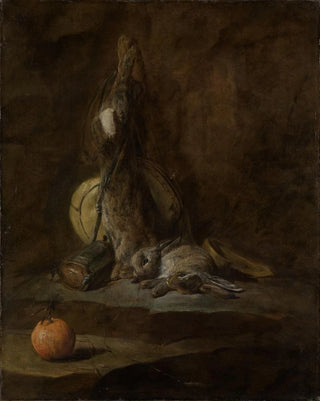Art print | Still life with a dead rabbit - Jean Siméon Chardin


View from behind

Frame (optional)
In the fascinating world of 18th-century painting, Jean Siméon Chardin stands out for his ability to capture the fleeting beauty of nature and everyday objects. The artwork "Nature morte avec un lapin mort" perfectly illustrates this approach, blending meticulous observation with emotional sensitivity. Chardin, with his keen eye, invites us to contemplate the simplicity of things through a composition that evokes life and death, while celebrating the beauty of forms and textures. This piece, emblematic of his style, is a true homage to nature and the fragility of existence.
Style and uniqueness of the work
The particularity of "Nature morte avec un lapin mort" lies in its treatment of objects. Chardin manages to infuse an almost palpable life into inanimate elements. The rabbit, realistically suspended, seems to tell a story, that of a frozen moment in time. The earthy colors, subtly diffused light, and thoughtful staging reveal impressive technical mastery. Every detail, from the rabbit's fur to the reflections on surfaces, is carefully rendered, demonstrating a deep understanding of materials. The composition, though simple, evokes emotional depth, encouraging the viewer to reflect on the relationship between man and nature, as well as mortality. Chardin succeeds in transcending the simple genre of art print to create a piece that resonates deeply with the human soul.
The artist and his influence
Jean Siméon Chardin, born in 1699, established himself as one of the masters of French painting. His work is set within an artistic context marked by Rococo, but he chose to move away from it by prioritizing simplicity and the truth of forms. Chardin was a pioneer in the art of art print, influencing many artists who followed. His realistic approach and ability to capture the essence of objects opened the way to a new appreciation of genre painting. By highlighting everyday details, he allowed viewers to rediscover beauty in the ordinary. His legacy endures.

Matte finish

View from behind

Frame (optional)
In the fascinating world of 18th-century painting, Jean Siméon Chardin stands out for his ability to capture the fleeting beauty of nature and everyday objects. The artwork "Nature morte avec un lapin mort" perfectly illustrates this approach, blending meticulous observation with emotional sensitivity. Chardin, with his keen eye, invites us to contemplate the simplicity of things through a composition that evokes life and death, while celebrating the beauty of forms and textures. This piece, emblematic of his style, is a true homage to nature and the fragility of existence.
Style and uniqueness of the work
The particularity of "Nature morte avec un lapin mort" lies in its treatment of objects. Chardin manages to infuse an almost palpable life into inanimate elements. The rabbit, realistically suspended, seems to tell a story, that of a frozen moment in time. The earthy colors, subtly diffused light, and thoughtful staging reveal impressive technical mastery. Every detail, from the rabbit's fur to the reflections on surfaces, is carefully rendered, demonstrating a deep understanding of materials. The composition, though simple, evokes emotional depth, encouraging the viewer to reflect on the relationship between man and nature, as well as mortality. Chardin succeeds in transcending the simple genre of art print to create a piece that resonates deeply with the human soul.
The artist and his influence
Jean Siméon Chardin, born in 1699, established himself as one of the masters of French painting. His work is set within an artistic context marked by Rococo, but he chose to move away from it by prioritizing simplicity and the truth of forms. Chardin was a pioneer in the art of art print, influencing many artists who followed. His realistic approach and ability to capture the essence of objects opened the way to a new appreciation of genre painting. By highlighting everyday details, he allowed viewers to rediscover beauty in the ordinary. His legacy endures.






